NIKKO 4x
| Dieses besondere Japanische NIKKO Monokular hat ein Erfle-Weitwinkel-Okular (Bild 12) und ein sehr großes Abbe-König-Prismen-System (Bild 13), welches den komplett mit dem Prismenstuhl das Volumen des Gehäuses ausfüllt. Der Objektivlinsendurchmesser ist jedoch nur 24mm. Das Gesichtsfeld wird am Okulartubus mit 15° beim vorliegenden Modell "No 10194" bzw. mit 17° bei den Exemplaren "No 10328" (s.a. http://www.cameraguild.jp/nekosan/ww2.html), No. 10843 sowie 10895 gekennzeichnet. Dies spricht dafür, dass im Laufe der Serienproduktion das Sehfeld erweitert werden konnte. | This special Japanese NIKKO monocular comes with an Erfle wide angle eyepiece (pic 12) and a very big Abbe-Koenig prism (pic 13), which with its prism chair completely fills the housing. But the objective aperture is only 24mm. The field of view is marked on the ocular tube being 15° for the model "No 10194" I have and being 17° for models "No 10328" (see http://www.cameraguild.jp/nekosan/ww2.html), No. 10843 as well as 10895. This hints to some construction change during the serial production increases the f.o.v. |
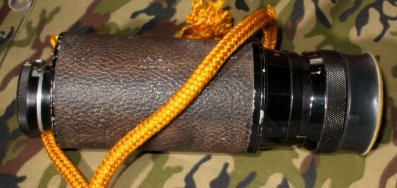
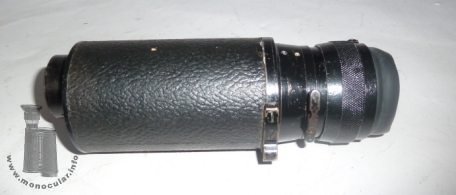
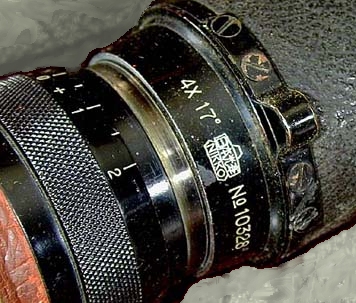
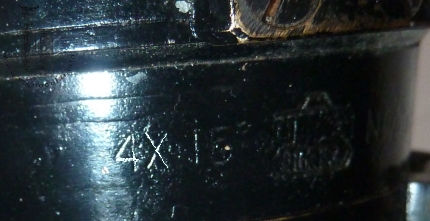
| Es gibt eine Dioptrieneinstellung, die sich mittels eines Hebels in geeigneter Position arretieren lässt. Am exentrisch versetzten (konischen) Objektivtubus können Filtergläser (gelb oder grau) aufgesteckt werden, welche anhand einer Federlippe am der Filterfassung an einer hervorstehenden Schraube am Objektiv einrasten. Am okularseitigem Ende des mit einem strukturiertem Hartgummi ummantleten Gehäuses ist eine Trageriemenöse angeschraubt. Am untern Deckel des zylindrischen Gehäuses befindet sich eine Schraube, die evtl. zur "Entlüftung" dient, da sie, wenn abgeschraubt, keine Befestigungfunktion hat. Das Okular hat eine Weichgummiaugenmuschel, die mit einem verschraubbaren Metallring fixiert ist. | There is a dioptre adjustment that can be fixed in a appropriate user position by means of a lever. You can slip filter glasses (yellow or grey) onto the short conical objective tube which is positioned offset to the centre. They are secured with ametal spring going over a protruding screw on the objective frame. At the eyepiece end of the cylindrical housing a strap lug is screwed on. There is a tiny screw on the bottom cover of the hosuing, which may just be there for dessication, because when screwed off, it does not hold anything. The housing is covered with textured ebonite, and the eyepiece has a soft rubber eyecup being fixed with a metal band (its ends are screwed together). |

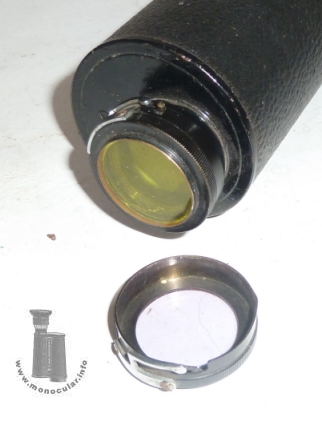
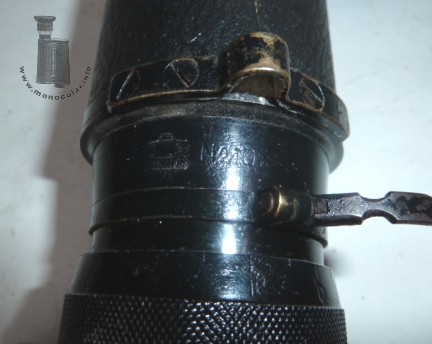
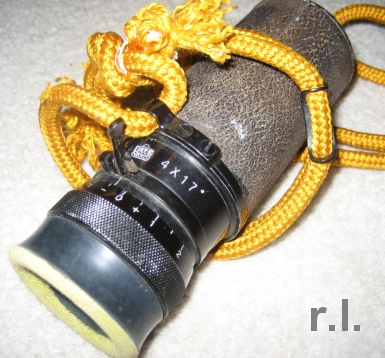
| Das Nikko 4x hat eine Strichplatte mit einer vertikalen Skala von 0-70 und einer horizontalen Skala von 0-150, wobei beide Nullpunkte links unten im Sehfeld starten (bild 11). Das Monokular wurde in einem Lederköcher mit Halterungen für die Filter innen am Deckel geliefert. | The NIKKO 4x has a reticle with a vertical scale ranging from zero to fifty, and a horizontal scale ranging from zero to 150. Both zero points are located at the bottom left of the field field of view (pic 11). The monocular comes with a leather case having straps inside the lid to hold the filter glasses. |
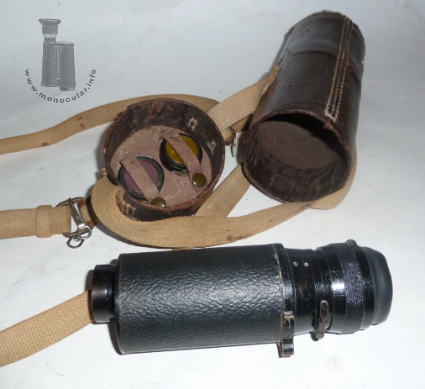
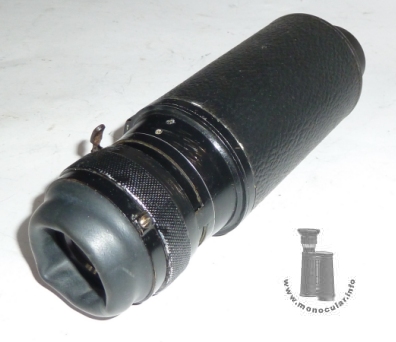
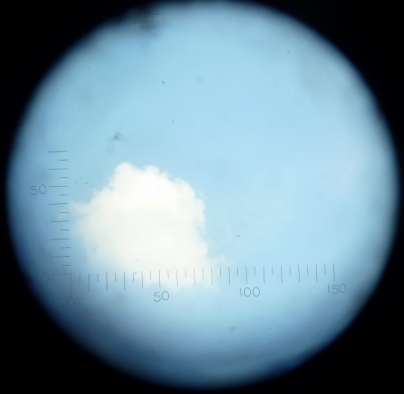
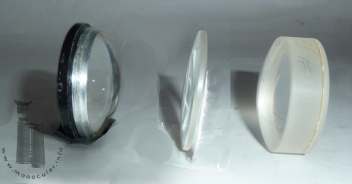
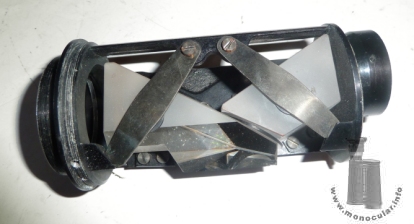
| Das Monokular wiegt 638g. Es ist 17cm lang und das zylindrische Gehäuse hat einen Durchmesser von 57,5mm. Die Objektivfassung ist am Ansatz 30mm, außen 34mm im Durchmesser. Das Okularstück beginnt bei 52,5mm und verjüngt sich zu 47mm im Durchmesser; der geriffelte Fokussierungsring ist 53mm und die Augenmuschel ca. 48mm im Durchmesser. Der 295g schewere Lederköcher ist 235mm lang und 87mm im Durchmesser. Die Filterfassugen sind 34mm, am geriffelten Rand 36mm im Durchmesser. | The 4x24 weighs 638g. 'It is 17cm long, and the cylindrical hosuing is 57.5mm in diameter. The objective frame starts with 30mm, and ends with 34mm in diameter. Theeyepiece decreases from 52.5mm to 47mm in diameter; the knurled focusing ring is 53mm, the eyecup about 48mm in diameter. The 295g case is 235mm long and 87mm in diameter. The filter frames are 34mm or 36mm at the knurled rim repsectively. |
Fotos: Zeun; 1, 8 R. Lane / http://www.cameraguild.jp/nekosan/ww2.html

